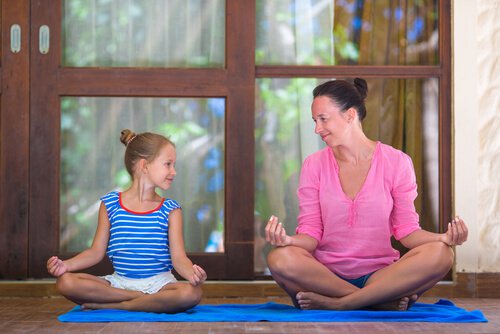Why and How to Teach Children to Meditate

Meditation and mindfulness have been viewed for a long time as activities for adults. But this view is beginning to change. There is now a growing interest in teaching children to meditate to help them relax, eliminate stress and learn how to connect with their own inner source of calm.
But who can teach children to meditate? Teaching children to meditate and practice mindfulness is something that even beginning meditators can do. You just need to have an interest, learn simple techniques, practice ahead of time and, above all, understand why meditation and the practice of mindfulness are so interesting.
Why teach children to meditate?
Busyness, technology, multitasking, overstimulation and speed are some of the features that seem to impose daily confusion in both adults and children. In this regard, the reasons to teach children to meditate are the same reasons we adults meditate: to connect with our self and absorb the energy of the earth.
The stress that we subject ourselves to results in fatigue and prevents us from concentrating and focusing. Adults convey this to children. Meditation is a tool that helps us become more aware of ourselves to capture positive energy and transmit it too.
Through meditation we learn to stay connected to the earth, live in the present moment and enjoy some quiet time. This allows us to relieve stress, stay connected with our essence and build a sense of self-love and self-esteem.

People who as children learn and practice meditation have tools to manage anxiety and stay focused. They can use this throughout life, enabling them to live more fully and consciously.
In addition, meditation has an additional value for children because it helps them improve concentration and learning. In this sense, meditation is a training of the mind that, by encouraging concentration, improves children’s interaction in the educational process. Something which promotes learning.
5 strategies to teach children to meditate
When we teach children meditation, we have to choose age-appropriate techniques for our young students. The following tips and strategies will serve to guide this teaching.
Be an example
If you want to teach a child to meditate, it is necessary that they see you do it to you first, or at least know how you do it. Knowing how to meditate is vital to know how beneficial it is. With it, you awaken curiosity in children. Older children can even identify the effect that meditation has had on you.
Once the child has a genuine and natural interest in meditation, you will be able to give them to a better understanding and promote their own practice.
Breathing is the anchor
All people who practice and teach meditation know that breathing is the beginning and end of all types of meditation. We take our breath with us at all times. Therefore, breathing becomes the anchor, it helps us focus on the present moment and place.
Children can learn this too simply by observing their breathing, noticing how their chest or your abdomen rises and falls with inhalation and exhalation. This helps them to be in the present moment, focus on their breathing and nowhere else. By doing it with them, the two of you will be anchored at that time together, which will also strengthen the bond between you.
Learn to adapt
Teaching meditation to children is a personal journey for them and for you. Children do not always respond the way adults want them to. This is the same with meditation. We can guide them in how to sit, close their eyes and all the steps to take, but if they do not want to they shouldn’t be forced to do it.
You should seek strategies to connect with their interests and provide tools to help them calm down and relax. Many children have difficulty being still or quiet, which is not bad, but it is a challenge.

Use your imagination
Adults spend a lot of time thinking rationally and analytically, but meditation is a time to be creative and let your imagination create a beautiful and safe place that little ones love also.
In any case, you can find many books for children with specific meditations that will help establish the environment. You can use those and from there you can create your own or let the child also collaborate in creating their own meditation.
Prepare for an extra dose of patience
The idea of teaching children to meditate may seem wonderful, but it is not easy. In fact, it can be very frustrating if you do not keep a flexible and patient perspective. Let the child develop their own curiosity, feel free when you propose meditations, and observe and “manage” the situation.
With children who are especially restless, it is interesting to introduce meditation as a great tool for them to own their own power and channel it properly.
Scientific Studies on Meditation
Science is currently studying the relationship between meditation and the physical structure of the brain. While it has long been known that this … More »
Meditation and mindfulness have been viewed for a long time as activities for adults. But this view is beginning to change. There is now a growing interest in teaching children to meditate to help them relax, eliminate stress and learn how to connect with their own inner source of calm.
But who can teach children to meditate? Teaching children to meditate and practice mindfulness is something that even beginning meditators can do. You just need to have an interest, learn simple techniques, practice ahead of time and, above all, understand why meditation and the practice of mindfulness are so interesting.
Why teach children to meditate?
Busyness, technology, multitasking, overstimulation and speed are some of the features that seem to impose daily confusion in both adults and children. In this regard, the reasons to teach children to meditate are the same reasons we adults meditate: to connect with our self and absorb the energy of the earth.
The stress that we subject ourselves to results in fatigue and prevents us from concentrating and focusing. Adults convey this to children. Meditation is a tool that helps us become more aware of ourselves to capture positive energy and transmit it too.
Through meditation we learn to stay connected to the earth, live in the present moment and enjoy some quiet time. This allows us to relieve stress, stay connected with our essence and build a sense of self-love and self-esteem.

People who as children learn and practice meditation have tools to manage anxiety and stay focused. They can use this throughout life, enabling them to live more fully and consciously.
In addition, meditation has an additional value for children because it helps them improve concentration and learning. In this sense, meditation is a training of the mind that, by encouraging concentration, improves children’s interaction in the educational process. Something which promotes learning.
5 strategies to teach children to meditate
When we teach children meditation, we have to choose age-appropriate techniques for our young students. The following tips and strategies will serve to guide this teaching.
Be an example
If you want to teach a child to meditate, it is necessary that they see you do it to you first, or at least know how you do it. Knowing how to meditate is vital to know how beneficial it is. With it, you awaken curiosity in children. Older children can even identify the effect that meditation has had on you.
Once the child has a genuine and natural interest in meditation, you will be able to give them to a better understanding and promote their own practice.
Breathing is the anchor
All people who practice and teach meditation know that breathing is the beginning and end of all types of meditation. We take our breath with us at all times. Therefore, breathing becomes the anchor, it helps us focus on the present moment and place.
Children can learn this too simply by observing their breathing, noticing how their chest or your abdomen rises and falls with inhalation and exhalation. This helps them to be in the present moment, focus on their breathing and nowhere else. By doing it with them, the two of you will be anchored at that time together, which will also strengthen the bond between you.
Learn to adapt
Teaching meditation to children is a personal journey for them and for you. Children do not always respond the way adults want them to. This is the same with meditation. We can guide them in how to sit, close their eyes and all the steps to take, but if they do not want to they shouldn’t be forced to do it.
You should seek strategies to connect with their interests and provide tools to help them calm down and relax. Many children have difficulty being still or quiet, which is not bad, but it is a challenge.

Use your imagination
Adults spend a lot of time thinking rationally and analytically, but meditation is a time to be creative and let your imagination create a beautiful and safe place that little ones love also.
In any case, you can find many books for children with specific meditations that will help establish the environment. You can use those and from there you can create your own or let the child also collaborate in creating their own meditation.
Prepare for an extra dose of patience
The idea of teaching children to meditate may seem wonderful, but it is not easy. In fact, it can be very frustrating if you do not keep a flexible and patient perspective. Let the child develop their own curiosity, feel free when you propose meditations, and observe and “manage” the situation.
With children who are especially restless, it is interesting to introduce meditation as a great tool for them to own their own power and channel it properly.
Scientific Studies on Meditation
Science is currently studying the relationship between meditation and the physical structure of the brain. While it has long been known that this … More »
This text is provided for informational purposes only and does not replace consultation with a professional. If in doubt, consult your specialist.







